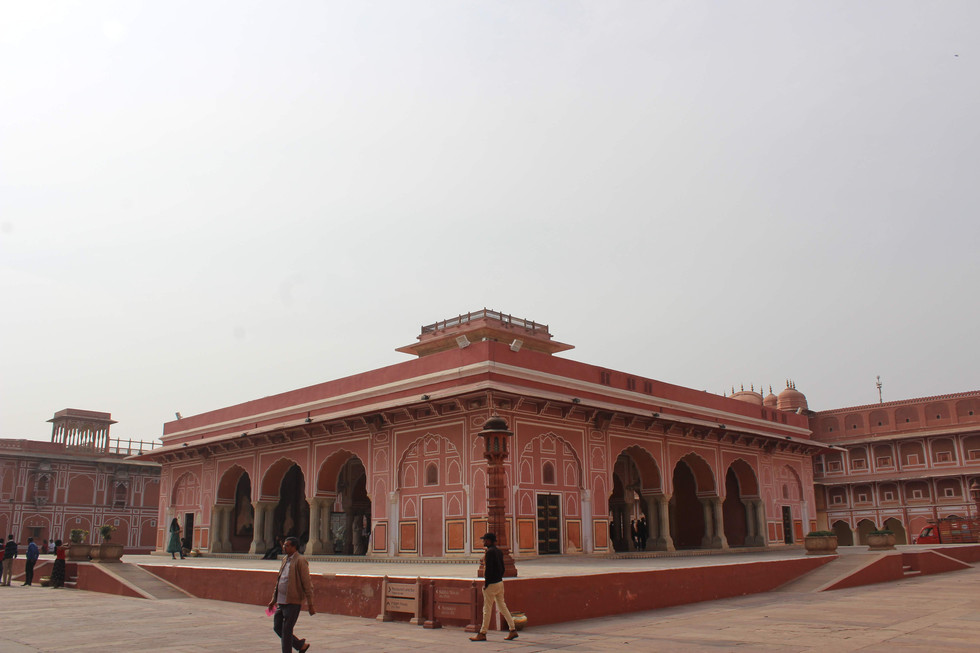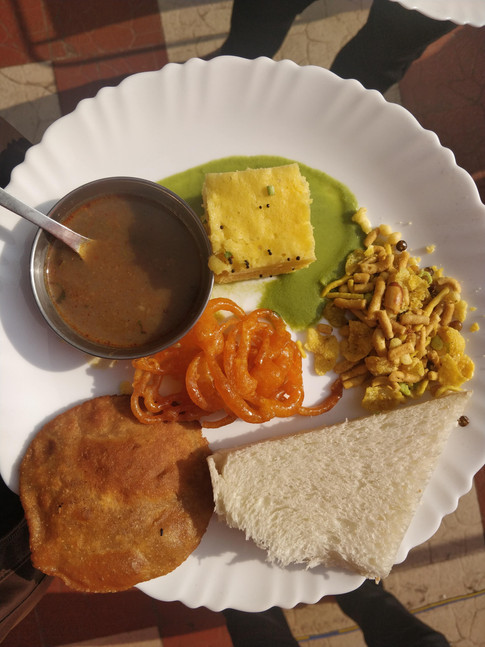The Royal Charm: Jaipur, the Pink City
- Sai Venkatesh Vemuri
- Sep 8, 2024
- 8 min read
Updated: Nov 12, 2024
Jaipur is a treasure trove of history, culture, and culinary delights. Its terracotta-coloured buildings, magnificent palaces, and formidable forts are reminiscent of the opulent era of the Rajputs, offering a captivating journey through time and tradition.

Table of Contents
Jaipur, the capital city of the Indian state of Rajasthan, is a vibrant and historic destination known for its rich culture and heritage. Founded in 1727 by Maharaja Sawai Jai Singh II, Jaipur is often referred to as the "Pink City" due to the distinct terracotta pink hue of its buildings. The city is renowned for its majestic palaces, imposing forts, and bustling bazaars.
Hawa Mahal
Hawa Mahal, also known as the "Palace of Winds," is one of Jaipur's most iconic landmarks. Built in 1799 by Maharaja Sawai Pratap Singh, this stunning five-story structure was designed by the architect Lal Chand Ustad from red and pink sandstone, reflecting the city's distinctive architectural style.

While the interior of Hawa Mahal is simpler, its narrow corridors and small chambers have a unique charm. From the top, you can enjoy stunning views of Jaipur's iconic landmarks.
Hawa Mahal features a unique honeycomb design with 953 small windows, known as jharokhas. These intricately carved windows allow for a cool breeze to flow through the palace, providing relief from the intense Rajasthan heat and giving the building its name, which means "Palace of Winds." This design also enabled the royal women, to observe street festivals and daily life without being seen by the public.

Hawa Mahal's facade is the quintessential postcard image of Jaipur, adorned with intricate latticework. I highly recommend visiting it both during the day and at night when it's beautifully illuminated.

Jantar Mantar
Jantar Mantar is a testament to the scientific and astronomical achievements of ancient India. Constructed by Maharaja Sawai Jai Singh II in the 18th century, this remarkable observatory is home to 19 massive instruments that were used to observe astronomical positions with the naked eye.
The term "Jantar Mantar" is derived from two Sanskrit words: "Yantra" and "Mantra." "Yantra" means "instrument" and "Mantra" can be interpreted as "calculation" Therefore, "Jantar Mantar" essentially translates to "instrument of calculation."

The Vrihat Samrat Yantra, meaning the "great king of instruments," is a massive 27-meter-high sundial and the largest stone sundial in the world. Watching the shadow slowly move across its surface is a mesmerizing experience, showcasing the ancient timekeeping tradition.
Recognized as a UNESCO World Heritage site, Jantar Mantar highlights the sophisticated techniques used to measure time, predict eclipses, and study celestial bodies, making it a must-visit for history and science enthusiasts.

City Palace
The City Palace in Jaipur is a stunning blend of Mughal and Rajasthani architecture, situated in the heart of the Pink City. Built in the early 18th century by Maharaja Sawai Jai Singh II, the palace complex houses a series of courtyards, gardens, and buildings that showcase the grandeur of the Rajput era.

The Diwan-i-Aam, or the Hall of Public Audience, is an open hall where the Maharaja addressed the general public and heard their grievances. The hall features a richly decorated ceiling, large chandeliers, and an extensive collection of miniature paintings, ancient manuscripts, and traditional artifacts. The hall also displays the golden throne of Maharaja.
The Diwan-i-Khas, or the Hall of Private Audience, is a grand chamber where the Maharaja used to meet his special guests and hold important discussions. This hall is renowned for its intricately decorated ceiling and the two enormous sterling silver vessels on display, which are listed in the Guinness Book of World Records as the largest silver vessels in the world. These vessels were used by Maharaja Sawai Madho Singh II to carry holy water from the Ganges when he traveled to England.
The Chandra Mahal is the most significant and tallest building in the City Palace complex. This seven-story structure serves as the residence of the royal family. The building is adorned with beautiful paintings, mirror work, and floral decorations, reflecting the rich heritage and royal lifestyle.

Built in the late 19th century by Maharaja Madho Singh II, the Mubarak Mahal, or the Welcome Palace, was originally intended to greet visiting dignitaries. This splendid structure combines Islamic, Rajput, and European architectural styles. Today, it houses a museum that showcases a remarkable collection of royal costumes and other textiles.
Pritam Niwas Chowk is the inner courtyard that features the four gates representing the seasons and dedicated to Hindu deities.
Lotus Gate: Representing summer, this gate is adorned with intricate lotus motifs and is dedicated to Lord Shiva and his consort, Parvati. The vibrant lotus flowers symbolize the beauty and tranquility of the summer season.
Peacock Gate: Symbolizing autumn, the Peacock Gate is a visual delight with its detailed peacock designs. It is dedicated to Lord Vishnu, who is often associated with this resplendent bird. The peacocks and autumnal hues reflect the rich cultural heritage of Rajasthan.
Rose Gate: This gate, symbolizing winter, is adorned with delicate rose patterns and is dedicated to Goddess Devi. The rose motifs and cooler colors evoke the serene and quiet beauty of winter.
Lehariya Gate: Representing spring, the Lehariya Gate is decorated with wave patterns in vibrant colors. It is dedicated to Lord Ganesha, the remover of obstacles. The lively designs and colors of this gate capture the essence and rejuvenation of spring.

Nahargarh Fort
Nahargarh Fort, perched on the rugged Aravalli hills overlooking the city of Jaipur, was constructed in 1734 by Maharaja Sawai Jai Singh II, the founder of Jaipur. Initially named Sudarshangarh, the fort was later renamed Nahargarh, meaning "Abode of Tigers."
One can explore the fort’s majestic structures and enjoy the breathtaking panoramic views of Jaipur.

Nahargarh Fort played a crucial role in the defense strategy of Jaipur along with Amber Fort and Jaigarh Fort. The fort was never attacked, but it served as a retreat for the royal family during times of conflict.

Puppet Show
A visit to Jaipur is incomplete without witnessing the traditional puppet show, a centuries-old art form that vividly brings the rich cultural heritage of the region to life. Known as "Kathputli," this traditional puppet theatre is a delightful blend of storytelling, music, and intricate puppetry that captivates audiences of all ages. You can find these enchanting performances at various locations throughout the city, including the City Palace and Hawa Mahal.
Amber Fort
Located just 11 kilometers from Jaipur, this magnificent fort is a blend of Hindu and Mughal architectural styles, showcasing the opulence and grandeur of a bygone era. Built in the late 16th century by Raja Man Singh I, Amber Fort served as the capital of the Kachwaha Rajputs before the establishment of Jaipur. Today, it remains one of the most iconic and visited attractions in Rajasthan, drawing visitors from around the world with its exquisite palaces, intricate carvings, and breathtaking views.

At the heart of the grandeur of Amber Fort lies its main entry point: the Suraj Pol, also known as the Sun Gate. Exclusively built and meticulously guarded, Suraj Pol served as the primary entryway into the palace complex. Facing eastwards, it greeted the rising sun, earning its name.

The next courtyard consists of Diwan-i-Aam or the Public Audience Hall. As the name suggests, the King held audience here to hear from the public.
Crafted with meticulous detail, Ganesh Pol is a masterful fusion of Hindu and Mughal architectural styles, showcasing delicate floral motifs, geometric patterns, and depictions of mythological scenes. The gate serves as the entrance to the private quarters of the palace, reserved for the royal family and their closest associates.
Upon entering, one can spot the intricate artwork adorning the ceiling with layers of genuine gold leafs.

Next, one enters the courtyard housing the Sheesh Mahal, also known as the Mirror Palace, a prime example of Rajput architecture and skillful craftsmanship. Its walls and ceilings are decorated with intricate floral and geometric designs, all crafted with care. Legend has it that the palace was built to resemble the night sky, with its mirrors reflecting the soft light of candles, creating a magical atmosphere inside.
Throughout the fort, you'll notice Jali design windows everywhere, adding to its charm. But there's one particular spot overlooking the lake that stands out as the best. The breeze and views from here are truly surreal, making it a must-visit spot during your exploration.

From atop the fort, one can behold the picturesque Kesar Kyari Garden, encircled by the serene lake. The gardens is also the spot to experience the enchanting sound and light shows in the evening.

Visitors can spot Turkish bath setup for the royals. Here, the water is heated using firewood from beneath, providing a luxurious bathing experience. Interestingly, amidst the palace's opulence, the toilets stand out as a simple feature. Back in the day, just having one was considered regal enough?
In this courtyard, you'll also find the Sukh Mahal, also known as the Hall of Pleasure. Its entrance, marked by a sandalwood door, leads you into a beautifully adorned space with marble walls. A smart design keeps the interior cool, with a piped water supply running through an open channel. This water then flows into the garden, where a hexagonal sunken bed awaits. Encircling a star-shaped pool, narrow marble channels add to the charm, all centered around a lovely fountain.
In the last courtyard, Zanana resided the women of the Royal Family. Each section is divided by partitions, offering individual living spaces for the women. The design ensures the king's private access to each section while upholding complete privacy for the residents.

As you leave through the Chandra Pol Gate, take a moment to admire the view of Jaipur's old city. From here, you can also catch sight of the fort walls stretching across the adjacent hillsides, spanning a total of 12 kilometers.

Amber Fort is undoubtedly the most beautiful fort in Jaipur, and you'll need at least 4 hours to fully explore it. Plan your visit for early in the day or during the evening. Don't miss the sound and light show, which adds an extra layer of magic to your experience.
Local Cuisine
In Jaipur, the food experience is a delightful journey for your taste buds. Be sure to sample the local snacks and sweets, like hot Kachoris and crispy Samosas. If you're visiting in winter, don't miss out on Ghewar, a seasonal favorite. And for a truly immersive culinary experience, treat yourself to a Rajasthani Thali, where you'll savor a variety of flavors all in one meal.

And that wraps up this journey! Be sure to explore more stories on this blog. I'd love to hear from you, so feel free to connect through the contact section.
Essential Information
Who should visit?
Nature Lover
Culinary Enthusiast
Weekender
Budget Explorer
Architecture Buff
When to visit?
Recommended - November to March
Avoid summers at all costs
Where to Stay?
Zostel Jaipur
What to do?
Explore Jantar Mantar, the remarkable astronomical observatory.
Visit the City Palace, a stunning blend of Rajasthani and Mughal architecture.
Discover Nahargarh Fort for breathtaking views of the city.
Tour Amber Fort, a magnificent example of Rajput architecture.
Enjoy a traditional puppet show, a cultural highlight of Jaipur.
Shop at Jaipur markets famous for pottery, clothes, jewellery, and more.
Explore the streets of Jaipur for amazing eats, from street food stalls to local eateries.
How to travel?
Jaipur is accessible by flight or train from major cities across India.
You can hire a bike or take auto-rickshaws for local travel.
Recommended Trip Duration
3 Days / 2 Nights
Estimated Trip Budget
~INR 15,000 per Person*
* Excluding transportation costs via flight or train, and if you'll be traveling around via public transport or in a group of four using a car.
_PNG.png)































































Comments